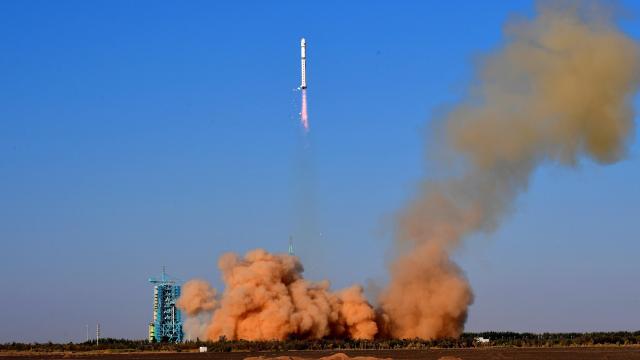The Long March 2D second stage is believed to have reentered over an unpopulated part of Texas on March 7 and so far there are no reports of injuries or damage to property. Sadly, as more rockets are sent to space and as rules around these matters remain vague, it’s the new normal we have to deal with.
Last week, bits of China’s Chang Zheng 2D ‘Long March’ rocket fell over Texas following a risky uncontrolled reentry through Earth’s atmosphere, according to the U.S. Space Command. The rocket’s second stage reentered over the southern region of North America on March 7 at 10:30 p.m. (local time), a statement from the U.S. Space Command is quoted in the U.S. Naval Institute News (USNI).
“This was an uncontrolled reentry, meaning it was not steered but rather its orbit decayed and lowered naturally,” the statement continued. “This type of behaviour reinforces the need for better international norms regarding high-risk uncontrolled reentries.”
The Yaogan 35 launches had a deorbit sail attached to their CZ-2D upper stage rockets to ensure their rapid reentry. 3 days after reentry of the first of these over Texas, the second one reentered Mar 11 1808 UTC over western Nepal after 225 days in space.
— Jonathan McDowell (@planet4589) March 12, 2023
Harvard-Smithsonian astrophysicist Jonathan McDowell claims that these upper stages utilise a deorbit sail to “ensure their rapid reentry” and that another Chinese rocket stage reentered on March 11.
The 2D Long March rocket launched in June 2022 carrying three military surveillance satellites to orbit. After delivering the satellites to orbit, the rocket’s second stage spent more than eight months circling the planet as its orbit gradually decayed over time. The rocket finally made an uncontrolled reentry, plunging through the atmosphere at a speed of 27,359 km per hour over west Texas, according to USNI. Specifically, the “rocket section entered the atmosphere over West Texas near Marathon before heading on a northeast track between Abilene and Austin,” reports USNI.
The potential debris field is quite large. Fortunately, the broken up pieces of the rocket didn’t seem to fall near a populated area as none of the debris has been found yet. Alternately, all the pieces burned up in the atmosphere — we’re still waiting on confirmation of that.
Research from last year showed that 60% of launches to low Earth orbit in 2020 resulted in a rocket body being left in orbit. These objects pose a risk to operational satellites, but as the research points out, “when intact stages return to Earth, a substantial fraction of their mass survives the heat of atmospheric reentry as debris” and many “surviving pieces are potentially lethal, posing serious risks on land, at sea and to people in aeroplanes.” The researchers, led by Michael Byers from the University of British Columbia, estimate a 10% chance of one of more casualties from falling rocket debris in the next decade.
More this story: Deaths From Falling Rocket Debris Are Highly Unlikely — but That’s Changing
China is not the only culprit in this regard. In 2016, a second stage belonging to SpaceX fell to Earth after spending one month in orbit, “with two refrigerator-sized fuel tanks reaching the ground intact,” Byers and his colleagues wrote. The mitigate these risks, the researchers say spent rocket bodies should be equipped with engines that can reignite, “enabling the launch provider to direct the rocket body away from populated areas, usually into a remote area of ocean.” Of course, that costs extra money and requires extra fuel on board. That’s not the kind of thing that launch providers, especially startups, want to hear.
The latest uncontrolled reentry over Texas is the most recent in a series of incidents caused by China’s Long March rockets. In November 2022, a Long March 5B core stage also fell uncontrollably towards Earth, breaking up over the eastern Pacific Ocean, with debris falling to the southwest of the Mexican coast. During its unpredictable descent, Spain had to shut down its airspace due to potential risk posed by the plummeting debris.
Following the inaugural launch of the March 5B rocket, bits of it fell onto the Ivory Coast, causing damage to people’s property. For the rocket’s second flight, the booster fell into the Indian Ocean away from populated areas. Later on its third flight in July 2022, it reentered Earth’s atmosphere as was visible from Malaysia, with pieces of space junk crashing down onto parts of Indonesia and Philippines.
